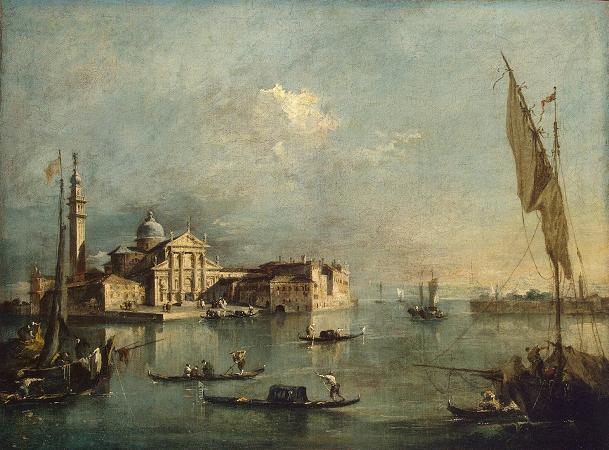Canaletto's Doge's Festivals (c1765). Giovanni Antonio Canal, commonly known as Canaletto, was an Italian painter from the Republic of Venice, considered an important member of the 18th-century Venetian school. Painter of city views or vedute, of Venice, Rome, and London, he also painted imaginary views, although the demarcation in his works between the real and the imaginary is never quite clearcut. He was further an important printmaker using the etching technique. In the period from 1746 to 1756 he worked in England where he painted many views of London and other sites including Warwick Castle and Alnwick Castle. He was highly successful in England, thanks to the British merchant and connoisseur Joseph Consul Smith, whose large collection of Canaletto's works was sold to King George III in 1762. He was born in Venice as the son of the painter Bernardo Canal, hence his mononym Canaletto, and Artemisia Barbieri. Canaletto served an apprenticeship with his father and his brother of a theatrical scene painter. Having already taken part in designing sets for operas by Fortunato Chelleri, Giovanni Porto, and Antonio Vivaldi, in 1718 Canaletto travelled to Rome. During his time in Rome he worked with his father producing the scenery for two operas by the composer Alessandro Scarlatti, Tito Sempronio Greco and Turno Aricino which were performed at the Teatro Catranica during the carnival season of 1720. Canaletto was inspired by the Roman vedutista Giovanni Paolo Pannini, and started painting the daily life of the city and its people. After returning from Rome in 1719, he began painting in his topographical style. His first known signed and dated work is Architectural Capriccio. Studying with the older Luca Carlevarijs, a well-regarded painter of urban cityscapes, he rapidly became his master's equal. In 1725, the painter Alessandro Marchesini, who was also the buyer for the Lucchese art collector Stefano Conti, had inquired about buying two more views of Venice, when the agent urged him to consider instead the work of Antonio Canale. it is like Carlevaris, but you can see the sun shining in it. Much of Canaletto's early artwork was painted from nature, differing from the then customary practice of completing paintings in the studio. Some of his later works do revert to this custom, as suggested by the tendency for distant figures to be painted as blobs of colour-an effect possibly produced by using a camera obscura, which blurs farther-away objects-although research by art historians working for the Royal Collection in the United Kingdom has shown Canaletto almost never used a camera obscura. However, his paintings are always notable for their accuracy: he recorded the seasonal submerging of Venice in water and ice. Canaletto's early works remain his most coveted and, according to many authorities, his best. One of his early pieces is The Stonemason's Yard which depicts a humble working area of the city. It is regarded one of his finest works and was presented by Sir George Beaumont in 1823 and 1828. Later Canaletto painted grand scenes of the canals of Venice and the Doge's Palace. His large-scale landscapes portrayed the city's pageantry and waning traditions, making innovative use of atmospheric effects and strong local colours. For these qualities, his works may be said to have anticipated Impressionism. Many of his pictures were sold to Englishmen on their Grand Tour, first through the agency of Owen Swiny and later the banker Joseph Smith. It was Swiny in the late 1720s who encouraged the artist to paint small topographical views of Venice with a commercial appeal for tourists and foreign visitors to the city. Sometime before 1728, Canaletto began his association with Smith, an English businessman and collector living in Venice who was appointed British Consul in Venice in 1744. Smith later became the artist's principal agent and patron, acquiring nearly fifty paintings, one hundred fifty drawings, and fifteen rare etchings from Canaletto, the largest and finest single group of the artist's works, which he sold to King George III in 1763. In the 1740s Canaletto's market was disrupted when the War of the Austrian Succession led to a reduction in the number of British visitors to Venice. Smith also arranged for the publication of a series of etchings of capricci in his vedute ideali, but the returns were not high enough, and in 1746 Canaletto moved to London, to be closer to his market. Whilst in England, between 1749 and 1752 Canaletto lived at number 41 Beak Street in London's Soho district. He remained in England until 1755, producing views of London and of his patrons' houses and castles.
more...







